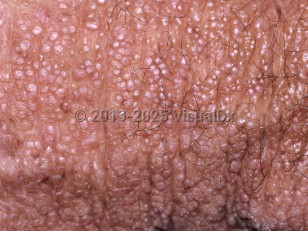Colloid milium
Alerts and Notices
Important News & Links
Synopsis

Adult colloid milium is the most common clinical form and has a 4:1 male preponderance, while the juvenile form is very rare and has been attributed to both autosomal dominant and autosomal recessive patterns of inheritance. The juvenile form has its onset in the prepubertal years and appears to be due to an abnormal susceptibility of keratinocytes to damage from ultraviolet (UV) light.
Nodular and pigmented colloid milium are subsets of the adult type, with the nodular form exhibiting larger nodules and plaques, mostly on the face, while the pigmented variety presents with confluent gray-brown papules on the face.
In addition to sunlight, both petroleum and phenols have been associated with rare occurrences of colloid milium. Hydroquinone exposure with resultant exogenous ochronosis contributes to the pigmented form.
The lesions of colloid milium tend to reach a peak within 3 years, after which few new papules occur. The lesions do not resolve and occasionally may be pruritic.
Codes
L57.8 – Other skin changes due to chronic exposure to nonionizing radiation
SNOMEDCT:
402684002 – Colloid milium
Look For
Subscription Required
Diagnostic Pearls
Subscription Required
Differential Diagnosis & Pitfalls

Subscription Required
Best Tests
Subscription Required
Management Pearls
Subscription Required
Therapy
Subscription Required
Drug Reaction Data
Subscription Required
References
Subscription Required
Last Updated:01/23/2020

